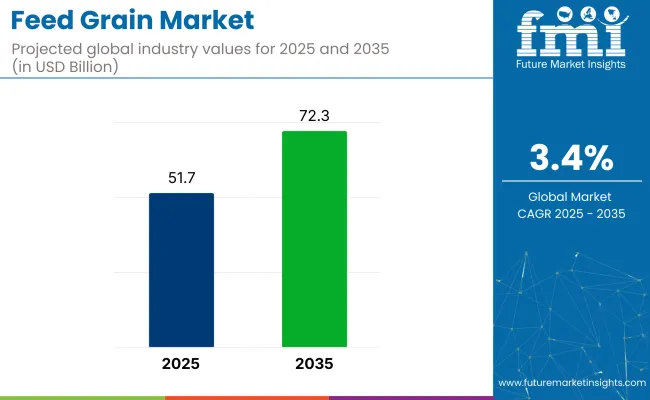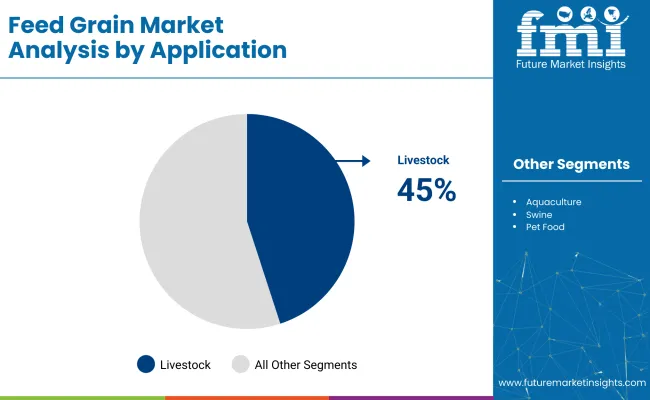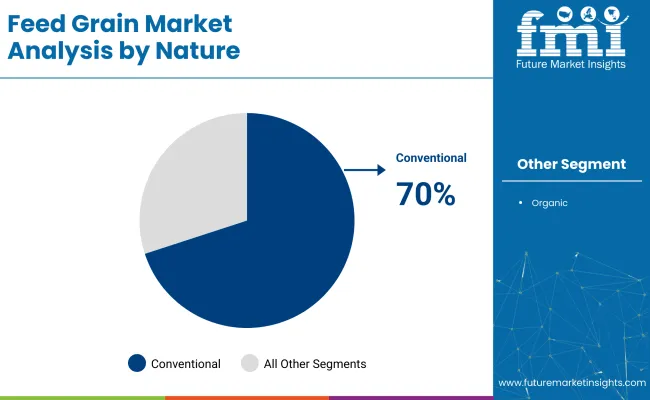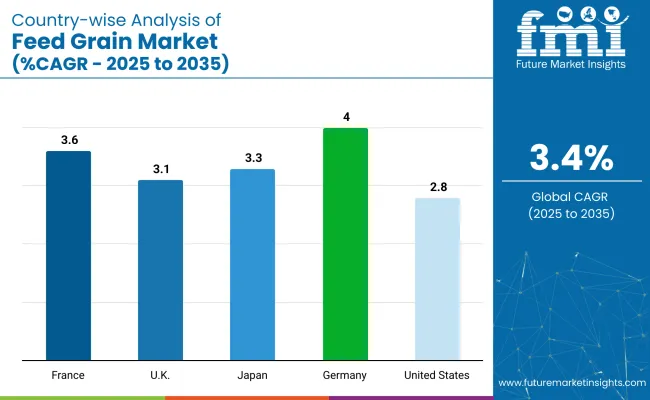The global feed grain market is projected to grow from USD 51.7 billion in 2025 to USD 72.3 billion by 2035, registering a CAGR of 3.4%. The market expansion is being driven by the increasing global demand for animal protein, growth of the livestock industry, and rising consumption of meat and dairy products.

| Metric | Value |
|---|---|
| Industry Size (2025E) | USD 51.7 billion |
| Industry Value (2035F) | USD 72.3 billion |
| CAGR (2025 to 2035) | 3.4% |
As the demand for premium livestock products increases, the need for high-quality feed grains like corn, wheat, and barley is becoming more significant across global markets. The market holds approximately 100% share of the livestock feed market, as feed grains are crucial for animal nutrition.
Within the agricultural segment, it commands around 35%, emphasizing its role in crop production for livestock segment. It contributes approximately 8%, reflecting its role in global agricultural output. However, in the food & beverage industry, the share is minimal, about 1%, while its contribution to agricultural commodities is around 2%.
Government regulations impacting the market focus on sustainable agriculture, food security, and animal health. Policies encouraging domestic feed grain production and reducing dependency on imports are boosting the market in countries like India, China, and the USA Additionally, international standards and certifications for feed grain quality, such as ISO 9001 and ISO 22000, guide industries to produce safe and nutritious feed. These regulations promote the adoption of advanced farming techniques and environmentally friendly practices, ensuring better feed quality and improved livestock health.
Germany is projected to be the fastest-growing market, expanding at a CAGR of 4% from 2025 to 2035. Livestock will lead the application segment with a 45% share, while conventional will dominate the nature segment with a 70% share. The USA, France, and Japan markets are also expected to grow steadily at CAGRs of 2.8%, 3.6%, and 3.3%, respectively.
The market is segmented by grain type, application, nature, and region. By grain type, the market is divided into corn, wheat, barley, sorghum, and others (oats, rye, millets). Based on application, the market is categorized into aquaculture (fish, shrimp, shellfish, others), livestock (poultry, ruminants, swine, equine, others), and pet food (dogs, cats, horses). Based on nature, the market is bifurcated into organic and conventional. Regionally, the market is classified into North America, Latin America, Europe, East Asia, South Asia, Oceania, and the Middle East & Africa.
Corn is expected to dominate the grain type segment, accounting for 36.8% of the market share by 2025, driven by its widespread use in livestock feed, particularly for poultry, swine, and other animals.
Livestock feed is expected to lead the application segment, capturing approximately 45% market share by 2025. Their demand is rising because of increasing protein consumption, changing dietary preferences, and the need for efficient feed solutions to support higher poultry production and meet global food security needs.

Conventional feed grains are expected to lead the nature segment, accounting for approximately 70% of the global market share by 2025. Their cost-effectiveness and widespread use in livestock feed production is increasing, across various regions.

The global market is experiencing steady growth, driven by the increasing demand for animal protein and the expansion of livestock industries. Feed grains play a critical role in ensuring optimal nutrition for livestock and poultry, supporting the growing global need for meat and dairy products.
Recent Trends in the Feed Grain Market
Challenges in the Feed Grain Market

Germany leads the market due to its thriving livestock industry, especially in poultry and cattle. Key regions, including developed economies like the USA (2.8% CAGR), UK (3.1%), Japan (3.3%), Germany (4%), and France (3.6%), are expanding at varying rates aligned with the global growth rate of 3.4%.
Japan follows with a steady growth rate, fueled by its robust poultry and swine industries, while France continues to grow with a focus on food security and sustainable farming practices. The USA market shows slower growth, driven by retrofitting agricultural practices and sustainability goals, whereas the UK focuses on increasing demand for poultry and pork feed despite post-Brexit uncertainties. These regions will shape long-term global demand for feed grains.
The report covers in-depth analysis of 40+ countries; five top-performing OECD countries are highlighted below.
The Japan feed grain revenue is poised to grow at a CAGR of 3.3% from 2025 to 2035. Growth is driven by the country’s robust livestock industry, especially in poultry and swine, along with rising demand for meat and dairy.
The sales of feed grains in Germany are poised to expand at 4% CAGR during the forecast period. Growth is driven by the thriving livestock industry, particularly in poultry and cattle, and increasing demand for meat and dairy.
The French feed grain market is projected to grow at 3.6% CAGR during the forecast period. Demand is driven by national food security policies, rising meat consumption, and the expansion of the livestock sector.
The USA feed grain market is projected to grow at 2.8% CAGR from 2025 to 2035. Growth is driven by rising demand from the retrofitting and updating of agricultural practices to meet changing consumer needs and sustainability goals.
The UK feed grain revenue is projected to grow at a CAGR of 3.1% from 2025 to 2035. Growth is driven by the increasing demand for livestock products, especially poultry and pork.
The market is moderately consolidated, with leading players like ADM, Cargill, Incorporated, Louis Dreyfus Company (LDC), GrainCorp., Ardent Mills, Stone House Grain, and Gavilon dominating the industry. These companies provide advanced, efficient feed grain solutions catering to industries such as livestock farming, food processing, and agriculture. ADM focuses on high-quality grain sourcing and logistics, while Cargill, Incorporated specializes in sustainable farming practices and feed formulations.
Louis Dreyfus Company (LDC) delivers integrated supply chain solutions for feed grains, and GrainCorp. is known for its efficient grain handling and export services. Other key players like Nutreco N.V., New Hope Liuhe Co., Ltd., Bartlett Milling Co., LP, Scoular, and Perdue Farms contribute by providing specialized, high-performance feed grain solutions for a wide range of industrial applications.
Recent Feed Grain Industry News
| Report Attributes | Details |
|---|---|
| Market Size (2025) | USD 51.7 billion |
| Projected Market Size (2035) | USD 72.3 billion |
| CAGR (2025 to 2035) | 3.4% |
| Base Year for Estimation | 2024 |
| Historical Period | 2020 to 2024 |
| Projections Period | 2025 to 2035 |
| Report Parameter | USD billion for value/volume in metric tons |
| Grain Type Analyzed | Corn, Wheat, Barley, Sorghum, and Others (Oats, Rye, Millets) |
| Application Analyzed | Aquaculture (Fish, Shrimp, Shellfish, Others), Livestock (Poultry, Ruminants (Cattle, Sheep, Goats), Swine, Equine, Others), and Pet Food (Dogs, Cats, Horses) |
| Nature Analyzed | Organic and Conventional |
| Region Analyzed | North America, Latin America, Europe, East Asia, South Asia, Oceania, and Middle East & Africa |
| Countries Covered | United States, Canada, United Kingdom, Germany, France, China, Japan, South Korea, Brazil, Australia |
| Key Players Influencing the Market | ADM, Cargill, Incorporated, Louis Dreyfus Company (LDC), GrainCorp., Ardent Mills, Stone House Grain, Gavilon, Nutreco N.V., New Hope Liuhe Co., Ltd., Bartlett Milling Co., LP, Scoular, Perdue Farms |
| Additional Attributes | Dollar sales by grain type, share by application, regional demand growth, policy influence, sustainability trends, competitive benchmarking |
The market is valued at USD 51.7 billion in 2025.
The market is forecast to reach USD 72.3 billion by 2035, reflecting a CAGR of 3.4%.
Conventional feed grains are expected to lead with a 70% market share in 2025.
Livestock feed will dominate the application segment with a 45% market share in 2025.
Germany is anticipated to be the fastest-growing market, with a CAGR of 4% from 2025 to 2035.






Our Research Products

The "Full Research Suite" delivers actionable market intel, deep dives on markets or technologies, so clients act faster, cut risk, and unlock growth.

The Leaderboard benchmarks and ranks top vendors, classifying them as Established Leaders, Leading Challengers, or Disruptors & Challengers.

Locates where complements amplify value and substitutes erode it, forecasting net impact by horizon

We deliver granular, decision-grade intel: market sizing, 5-year forecasts, pricing, adoption, usage, revenue, and operational KPIs—plus competitor tracking, regulation, and value chains—across 60 countries broadly.

Spot the shifts before they hit your P&L. We track inflection points, adoption curves, pricing moves, and ecosystem plays to show where demand is heading, why it is changing, and what to do next across high-growth markets and disruptive tech

Real-time reads of user behavior. We track shifting priorities, perceptions of today’s and next-gen services, and provider experience, then pace how fast tech moves from trial to adoption, blending buyer, consumer, and channel inputs with social signals (#WhySwitch, #UX).

Partner with our analyst team to build a custom report designed around your business priorities. From analysing market trends to assessing competitors or crafting bespoke datasets, we tailor insights to your needs.
Supplier Intelligence
Discovery & Profiling
Capacity & Footprint
Performance & Risk
Compliance & Governance
Commercial Readiness
Who Supplies Whom
Scorecards & Shortlists
Playbooks & Docs
Category Intelligence
Definition & Scope
Demand & Use Cases
Cost Drivers
Market Structure
Supply Chain Map
Trade & Policy
Operating Norms
Deliverables
Buyer Intelligence
Account Basics
Spend & Scope
Procurement Model
Vendor Requirements
Terms & Policies
Entry Strategy
Pain Points & Triggers
Outputs
Pricing Analysis
Benchmarks
Trends
Should-Cost
Indexation
Landed Cost
Commercial Terms
Deliverables
Brand Analysis
Positioning & Value Prop
Share & Presence
Customer Evidence
Go-to-Market
Digital & Reputation
Compliance & Trust
KPIs & Gaps
Outputs
Full Research Suite comprises of:
Market outlook & trends analysis
Interviews & case studies
Strategic recommendations
Vendor profiles & capabilities analysis
5-year forecasts
8 regions and 60+ country-level data splits
Market segment data splits
12 months of continuous data updates
DELIVERED AS:
PDF EXCEL ONLINE
Horse Grain Feeders Market Size and Share Forecast Outlook 2025 to 2035
Organic Dried Distillers Grain Feed Market Size and Share Forecast Outlook 2025 to 2035
Feed Mixer for Livestock Market Size and Share Forecast Outlook 2025 to 2035
Feed Preparation Machine Market Size and Share Forecast Outlook 2025 to 2035
Feed Additive Nosiheptide Premix Market Size and Share Forecast Outlook 2025 to 2035
Feeder Container Market Size and Share Forecast Outlook 2025 to 2035
Feed Machine Market Forecast Outlook 2025 to 2035
Feed Pigment Market Forecast and Outlook 2025 to 2035
Feed Mixer Market Forecast and Outlook 2025 to 2035
Feed Grade Spray-dried Animal Plasma (SDAP) Market Size and Share Forecast Outlook 2025 to 2035
Feed Electrolytes Market Size and Share Forecast Outlook 2025 to 2035
Feed Micronutrients Market Size and Share Forecast Outlook 2025 to 2035
Feed Acidifier Market Analysis Size Share and Forecast Outlook 2025 to 2035
Feed Flavors Market Size and Share Forecast Outlook 2025 to 2035
Feed Enzymes Market Analysis - Size, Share, and Forecast Outlook 2025 to 2035
Feed Mycotoxin Binders Market Size and Share Forecast Outlook 2025 to 2035
Feed Phytogenics Market Size and Share Forecast Outlook 2025 to 2035
Feed Carbohydrase Market Size and Share Forecast Outlook 2025 to 2035
Feed Grade Oils Market Analysis - Size, Share, and Forecast Outlook 2025 to 2035
Feed Packaging Market Size, Share & Forecast 2025 to 2035

Thank you!
You will receive an email from our Business Development Manager. Please be sure to check your SPAM/JUNK folder too.
Chat With
MaRIA